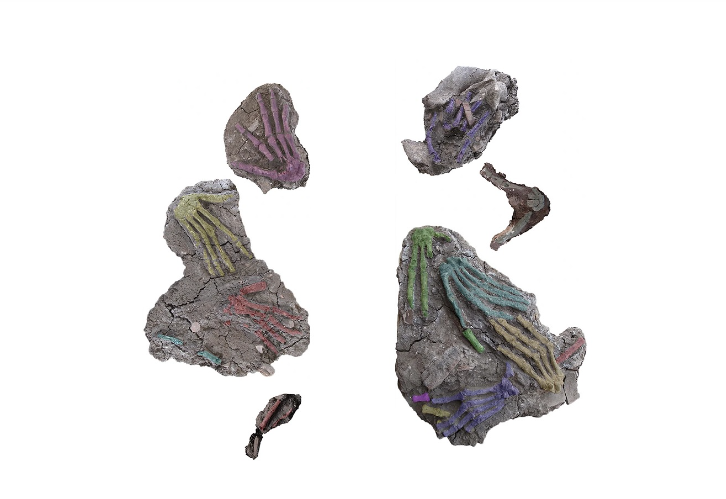
© Stefanović, D
IN A NEW STUDY PUBLISHED IN THE JOURNAL SPRINGER
, THE SEVERED RIGHT HANDS FROM 12 INDIVIDUALS HAVE BEEN ANALYSED OSTEOLOGICALLY,
REVEALING TROPHY-TAKING PRACTICES IN ANCIENT EGYPT.The severed right hands were discovered by archaeologists in three pits in the courtyard of the Hyksos palace at Avaris/Tell el-Dab'a in north-eastern Egypt.
The palace dates from the 15th Dynasty (1640-1530 BC), during which time the Lower and Middle Egypt up to Cusae was ruled by the Hyksos kings, marking the first period in which Egypt had foreign rulers.
Although the practice of placing severed hands is documented in tomb inscriptions and temple reliefs from the New Kingdom onwards, this is the first example of an osteological analysis using physical evidence.Anatomical markers indicate that the hands are from at least 12 adults, belonging to 11 males and possibly one female. Once the attached parts of the forearm were removed, the hands were deposited in the pits with the fingers wide-splayed, primarily on their palm-facing sides.
The positioning of the hands on their palmar surfaces with splayed fingers may have been caused by taphonomic reasons, or they may have been due to their deliberate placement.
Out of all the hands found, only six have intact proximal row carpal bones, and there are no indications of cut marks or any removal of soft tissue. Since no fragments of lower arm bones were recovered from the pit, it suggests that these hands were deliberately detached from the lower arms.
One way to amputate hands is to slice through the joint capsule and then cut across the tendons that span the wrist joint. If done correctly, there will be no visible marks on the bones. However, if done unskilfully, cut marks may be present.
Mutilating people without regard to their survival is often done by severing the arm at any anatomical position. This method is faster and easier, but it leaves a section of the lower arm attached to the hand. If this was the case with these hands, the people offering them, or those in charge of the ceremony, cared enough about their proper presentation to detach parts of the lower arm.
In either scenario, it is likely that the hands were still soft and flexible when they were deposited into the pit. This suggests that they were either placed there prior to the onset of rigor mortis or after it had dissipated. Rigor mortis in the hands typically commences 6-8 hours after death. Thus, it is probable that living individuals were dismembered during or shortly before the ceremony.
According to the study: "Taphonomic and biological analyses carried out on the bones reveal information regarding the act of mutilation and preparation of these body parts, as well as about the individuals to whom they originally belonged."
While it is not possible to identify the particular ethnic or cultural group to which the hands belong, it is believed that the practice of severing the right hands of enemies was introduced to Egypt by the Hyksos roughly 50-80 years prior to the appearance of inscriptions and images depicting the practice. The Ancient Egyptians adopted this during the reign of King Ahmose, as evidenced by a depiction of a stack of hands at his temple in Abydos.
The placement, handling, and potential arrangement of the amputated hands provide evidence against the theory that these actions were carried out as punitive measures by law enforcement. When viewed through a transdisciplinary lens that considers archaeological and historical sources, the bioarchaeological data presented indicates that the severed hands were presented as prizes during a public event held at the palace.
Reference: First osteological evidence of severed hands in Ancient Egypt
Reader Comments
My interpretation suggests that the fingers are disproportionately long to the hand and the even the last digit ( small finger ) is way far too long.
There is a suggestion that these are not full hands and that a 6th digit is missing, if so, these are the hands of giants, who had six fingers.
Meat Puppets
Fear and loathing of another, a transgressor.
In modern military dialogue, to wipe them off the face of the earth.
And in this endeavor, billions upon billions...going into trillions in the world of printed money and possibly reaching beyond that of Gillions. Well, if one can print paper, one can print money,
So the question remains, did he lose his hands, because he stole a loaf of bread or
Billions?